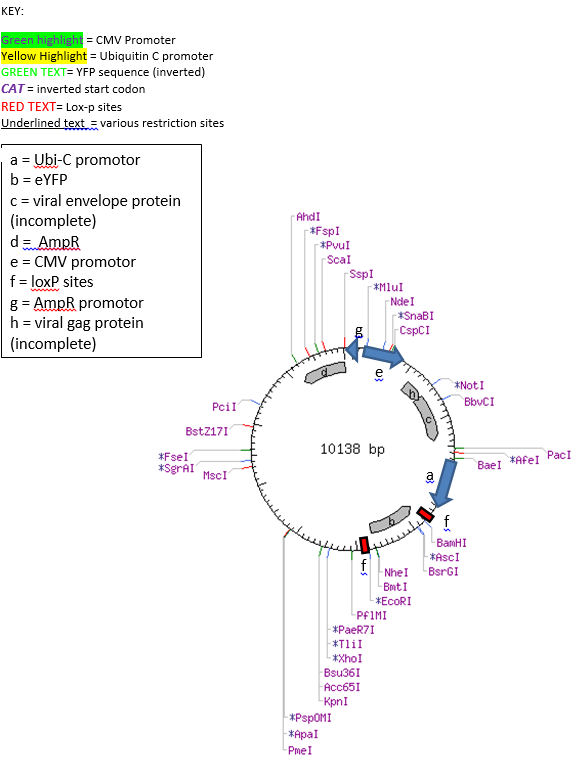-
PurposeFor expressing YFP in mammalian cells upon Cre co-expression. Can be made into Lentivirus.
-
Depositing Lab
-
Sequence Information
Ordering
| Item | Catalog # | Description | Quantity | Price (USD) | |
|---|---|---|---|---|---|
| Plasmid | 73858 | Standard format: Plasmid sent in bacteria as agar stab | 1 | $85 | |
Backbone
-
Vector backbonepFUGW
- Backbone size w/o insert (bp) 9421
- Total vector size (bp) 10138
-
Vector typeMammalian Expression, Lentiviral
Growth in Bacteria
-
Bacterial Resistance(s)Ampicillin, 100 μg/mL
-
Growth Temperature37°C
-
Growth Strain(s)NEB Stable
-
Copy numberLow Copy
Gene/Insert
-
Gene/Insert nameeYFP
-
Alt nameenhanced yellow fluorescent protein
-
SpeciesSynthetic
-
Insert Size (bp)717
Cloning Information
- Cloning method Restriction Enzyme
- 5′ cloning site BamHI (unknown if destroyed)
- 3′ cloning site EcoRI (unknown if destroyed)
- 5′ sequencing primer None
- 3′ sequencing primer None (Common Sequencing Primers)
Resource Information
-
Addgene Notes
-
A portion of this plasmid was derived from a plasmid made byJerry Chen
-
Article Citing this Plasmid
Terms and Licenses
-
Academic/Nonprofit Terms
-
Industry Terms
- Not Available to Industry
Trademarks:
- Zeocin® is an InvivoGen trademark.
Depositor Comments
Please note that this backbone is prone to recombination. Addgene recommends that, upon receipt of this plasmid, users please streak onto an LB plate and screen single colonies by restriction digest before subsequent growth, storage, and experimentation.
This plasmid can be used with the low-efficiency Cre in Plasmid 101242: pSin wPGK-Cre ( https://www.addgene.org/101242/ ).
These plasmids were created by your colleagues. Please acknowledge the Principal Investigator, cite the article in which the plasmids were described, and include Addgene in the Materials and Methods of your future publications.
-
For your Materials & Methods section:
FU - dio YFP - W was a gift from Elly Nedivi (Addgene plasmid # 73858 ; http://n2t.net/addgene:73858 ; RRID:Addgene_73858) -
For your References section:
Inhibitory Synapses Are Repeatedly Assembled and Removed at Persistent Sites In Vivo. Villa KL, Berry KP, Subramanian J, Cha JW, Oh WC, Kwon HB, Kubota Y, So PT, Nedivi E. Neuron. 2016 Feb 3. pii: S0896-6273(16)00011-8. doi: 10.1016/j.neuron.2016.01.010. 10.1016/j.neuron.2016.01.010 PubMed 26853302






